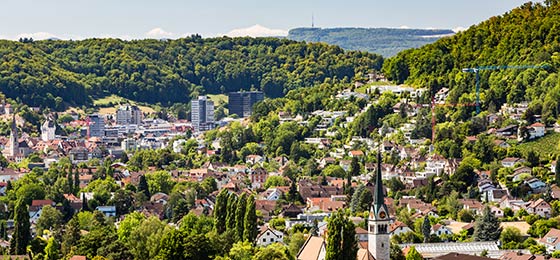The causes of soil consumption

Since the 1950s, urban sprawl in Switzerland has been progressing virtually unchecked. The trend towards greater levels of soil consumption is expected to continue until the middle of this century, albeit at a slower pace.
A group of researchers led by Felix Kienast from the Swiss Federal Institute for Forest, Snow and Landscape Research (WSL) has investigated this issue as part of the National Research Programme “Sustainable use of soil as a resource” (NRP 68). The aim was to investigate the causes behind urban sprawl.
Transport links favour urban sprawl
A statistical analysis of various available data sets for soil consumption and socio-economic development showed that urban sprawl and its impact on soil consumption cannot be adequately explained by population growth alone. Other developments have had a much more significant influence, such as the increase in single-occupant households.
In particular, a municipality's transport links favour urban sprawl. Multi-decade comparisons have shown that once a certain degree of urbanisation has been reached, the effect of good accessibility is reversed and it encourages consolidation. So at present, it is the relatively easily accessible, but not yet highly urbanised conurbations that are most affected by urban sprawl.
Almost 70% of Swiss municipalities completed a survey* on their spatial planning activities. As a result, the research team was able to analyse the applied planning instruments by canton, municipality size and type of municipality. This highlighted a strong connection to the size of the municipality.
Support in a planning association
In many small municipalities, Town Chancellors bear the administrative burden of planning activities. Larger municipalities often have an administrative department (for example, the building authority), which also handles planning activities, or they may even have a separate spatial planning department. Such municipalities are much better equipped to employ newer and more sophisticated planning instruments, such as special land use plans with urban planning requirements.
Since they are under significant settlement pressure, urban centres and conurbations enforce stricter planning measures than small and peripheral municipalities, for example, limiting low-density areas (estates with detached houses) or coordinating zoning with public transport provision. The more active of the small communities tend to focus on measures to prevent land grabbing or they apply very low usage figures that are intended to promote a compact residential area and consolidated conurbation development.
The analyses also illustrate that the municipalities should not be considered in isolation. Spatial planning measures and the development of a municipality always have a significant impact on surrounding municipalities. Researchers’ recommendations: Implementing instruments to combat urban sprawl to maximum effect requires a high level of regional coordination. Small municipalities with little planning capacity need professional support, for example, in the form of a planning association.
(*) Kaiser N. et al.: Raumplanung in den Schweizer Gemeinden: Ergebnisse einer Umfrage, WSL Berichte, Volume 42, 2016, ISSN 2296-3456 (download) http://www.wsl.ch/dienstleistungen/publikationen/pdf/15446.pdf
“Sustainable Use of Soil as a Resource” (NRP 68)
The Swiss National Science Foundation has been mandated by the Federal Council to conduct the National Research Programme “Sustainable Use of Soil as a Resource” (NRP 68). The aim is to compile knowledge about soil systems as well as evaluation instruments and strategies for dealing with soil for political decision-making purposes. The overall final recommendations of NRP 68 will be published in different syntheses reports starting from 2018.
Contact
Prof Felix Kienast
Swiss Federal Institute for Forest, Snow and Landscape Research (WSL)
Zürcherstrasse 111
CH-8903 Birmensdorf
Phone: +41 (0)44 739 23 66
E-mail: felix.kienast@wsl.ch
http://www.snf.ch/en/researchinFocus/newsroom/Pages/news-160614-press-release-th… Press release “The causes of soil consumption”
http://www.nfp68.ch/de NRP 68 “Sustainable Use of Soil as a Resource”
http://p3.snf.ch/Project-142996 Project in the SNSF P3 research database
http://www.nfp68.ch/en/projects/key-aspect-4-geoinformation-and-governance/proje… NRP 68 urban sprawl project
https://twitter.com/snsf_ch SNSF on Twitter
Media Contact
All latest news from the category: Ecology, The Environment and Conservation
This complex theme deals primarily with interactions between organisms and the environmental factors that impact them, but to a greater extent between individual inanimate environmental factors.
innovations-report offers informative reports and articles on topics such as climate protection, landscape conservation, ecological systems, wildlife and nature parks and ecosystem efficiency and balance.
Newest articles

First-of-its-kind study uses remote sensing to monitor plastic debris in rivers and lakes
Remote sensing creates a cost-effective solution to monitoring plastic pollution. A first-of-its-kind study from researchers at the University of Minnesota Twin Cities shows how remote sensing can help monitor and…

Laser-based artificial neuron mimics nerve cell functions at lightning speed
With a processing speed a billion times faster than nature, chip-based laser neuron could help advance AI tasks such as pattern recognition and sequence prediction. Researchers have developed a laser-based…

Optimising the processing of plastic waste
Just one look in the yellow bin reveals a colourful jumble of different types of plastic. However, the purer and more uniform plastic waste is, the easier it is to…



